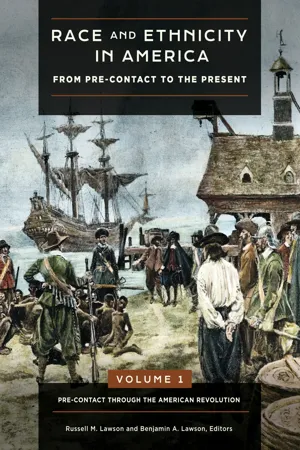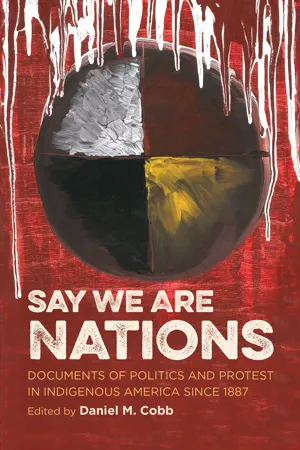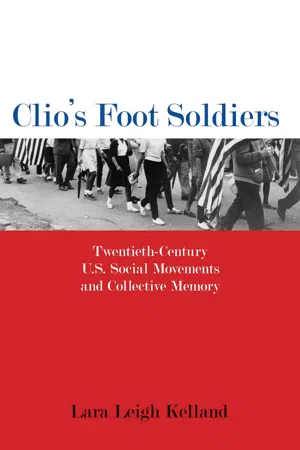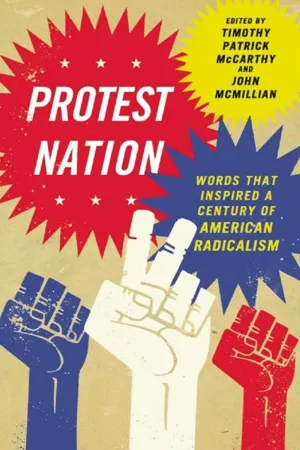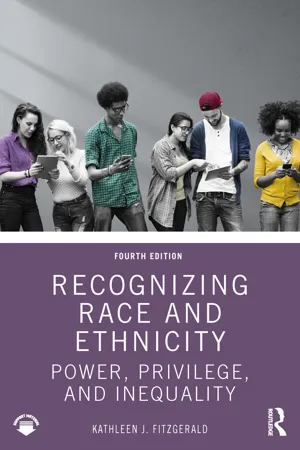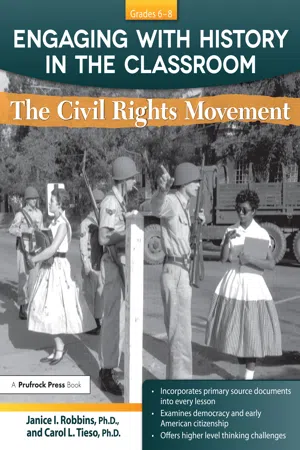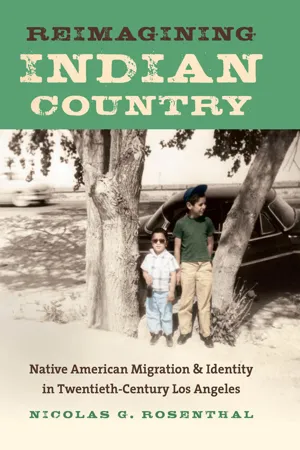History
American Indian Movement
The American Indian Movement (AIM) is a Native American civil rights organization founded in 1968 to address systemic issues facing Indigenous peoples in the United States. AIM sought to combat racism, poverty, and police brutality, and to promote the preservation of Native American culture and traditions. The movement gained attention for its advocacy and activism, including the occupation of Wounded Knee in 1973.
Written by Perlego with AI-assistance
Related key terms
11 Key excerpts on "American Indian Movement"
- eBook - ePub
Race and Ethnicity in America
From Pre-contact to the Present [4 volumes]
- Russell M. Lawson, Benjamin A. Lawson, Russell M. Lawson, Benjamin A. Lawson, Russell M. Lawson, Benjamin A. Lawson(Authors)
- 2019(Publication Date)
- Greenwood(Publisher)
In the early 1970s, AIM opened a number of Survival Schools to serve as an educational alternative to the dominant school system that the Native community felt did not serve the needs of Native children. The educational crisis of Native children in the Twin Cities public school system and elsewhere was manifest in abysmal dropout rates, high truancy, socioeconomic alienation, and ignorance, racial bias, and outright hostility from fellow students, teachers, and administrators toward cultural difference. Native Twin Cities’ residents felt that assimilationist pressures to conform to dominant society ultimately eroded Native students’ cultural identity and self-worth. Two Survival Schools were founded in 1972: the Heart of the Earth Survival School in Minneapolis in January as well as the Red School House in St. Paul in spring of the same year. The Heart of the Earth Survival School was in existence until 2008 when it was forced to close due to financial discrepancies; the Red School House was in existence until 1995. AIM Survival Schools were recognized as places strengthening Native communities and reclaiming indigenous knowledge systems and cultural identities. As Native community-controlled institutions, they were also considered to be vehicles of indigenous decolonization efforts through educational self-determination.The American Indian Movement and Protest ActivismThe between 1969 and 1973, AIM became one of the most prominent Native activist organizations with numerous chapters across the nation. The militant Nativeness that AIM members embodied at various protest events was accompanied by considerable media attention, frequently propelling AIM’s leaders into the spotlight of news networks and leaving the grassroots efforts of local people or women activists unnoticed. However, to mainstream America, Native Americans were invisible. Their small population in relation to other minorities and the cross-cultural situatedness of Native communities within America (either on the fringes of society on remote reservations in the American heartland or in urban areas) left Native Americans invisible and without a voice. Native activists had to be particularly concerned to gain the media’s attention, something that was frequently only possible through militant protest.The use of the media to draw attention to Native issues played a significant role throughout AIM’s existence. Frequently, AIM’s protest activism—its agenda, its tactics, and its strategies—revolved around drawing media attention to their grievances. Media coverage functioned to air Native grievances, to draw attention to public figures of Indian Affairs, and to transmit information about new forms of protest and contention to other potential protesters. Dennis Banks (Ojibwe) and Clyde Bellecourt (Ojibwe), the organization’s cofounders, as well as a number of other activists that joined later—Russell Means (Lakota), Carter Camp (Ponca), John Trudell (Sioux), and Vernon Bellecourt (Ojibwe), Clyde’s brother—would eventually become the public faces of AIM. Dennis Banks and Russell Means are probably the most photographed Native Americans of the twentieth century. Male AIM members became perhaps most notorious for its imagery of hypermasculine warriors that attracted nationwide news media attention. - eBook - ePub
H. Eugene and Lillian Youngs Lehman Series
Documents of Politics and Protest in Indigenous America since 1887
- Daniel M. Cobb(Author)
- 2015(Publication Date)
- The University of North Carolina Press(Publisher)
4Activists simultaneously carried forward the struggle for sovereignty at home. The American Indian Movement emerged as the most visible force, spearheading the Trail of Broken Treaties and Bureau of Indian Affairs (BIA) occupation in November 1972 and the standoff against the federal government and Pine Ridge tribal council at Wounded Knee in the early months of 1973. AIM originated in the Minneapolis–St. Paul area in July 1968 and initially focused on discrimination and police violence in urban communities. Its scope soon broadened to include all Native—and ultimately all indigenous—peoples. Their Twenty Points, drafted in large measure by NIYC member and fishing rights veteran Hank Adams (Assiniboine) for the Trail of Broken Treaties, provided a clear articulation of the Native rights agenda, one founded on tribal sovereignty, treaty rights, and the restoration of nation-to-nation relationships.5By the mid-1970s, the federal government abandoned termination in favor of an approach founded on the principle of self-determination. A flurry of legislation followed, including the Indian Self-Determination and Education Assistance Act (1975), the Indian Child Welfare Act (1978), the American Indian Religious Freedom Act (1978), the Indian Gaming Regulatory Act (1988), the Native American Graves Protection and Repatriation Act (1990), and the Indian Self-Governance Act (1994). In addition, the Taos Pueblos secured the return of their sacred Blue Lake in 1970; the following year, the Alaska Native Claims Settlement Act recognized title to 40 million acres of land, provided monetary compensation, and established twelve regional corporations to promote economic development; and in 1980, Penobscots and Passamaquodies wrested an $81.5 million settlement from Congress for the illegal taking of what amounted to two-thirds of the state of Maine.6 - eBook - ePub
Clio's Foot Soldiers
Twentieth-Century U.S. Social Movements and Collective Memory
- Lara Leigh Kelland(Author)
- 2018(Publication Date)
- University of Massachusetts Press(Publisher)
6 Some private, some facilitated by the Bureau of Indian Affairs (BIA), boarding schools removed Native youth from their tribal and familial contexts and sought to acculturate the next generation of Native communities in the ways of hegemonic American society, oftentimes through significant brutality and neglect. Boarding school policy prohibited the use of tribal languages, and school leadership usually understood that part of their institutional mission was to eradicate the traditional cultural practices of Native communities. As such, boarding schools increasingly became a target of Native activism during the twentieth century, and the schools served as both a potent symbol of the need for self-determination and cultural autonomy and a touchstone for the cultural activism engaged in this chapter.Arguably the most well-known manifestation of Native resistance in the twentieth century emerged in 1968 as the American Indian Movement (AIM). Building on the Pan-Indian consciousness that emerged in city centers during the earlier decades of urban relocation and community-building, movement leadership framed contemporary political struggles in the long history of Native/U.S. relations. Specifically, AIM activists sought “to halt America’s longest war, which has continued for 483 years against the Native, sovereign, indigenous people; against our culture and our spiritual way of life; and against our Mother Earth.”7 In both outward-facing press releases and internal movement discourse, AIM activists framed their actions with a well-integrated sense of the interconnectedness of past, present, and future anticolonial resistance.Education and Self-Determination
Indigenous activists had espoused sovereignty as a political goal and organizing principle for Native communities for much of the twentieth century. Although the founding of AIM in Minneapolis in July 1968 institutionalized Red Power, significant intellectual and activist underpinnings predated the organization’s formation by a few decades.8 The first long-lasting Pan-Indian political organization, the National Congress of American Indians (NCAI), was founded in 1944. Organized by boarding school graduates who had close ties to their individual tribes, early NCAI members had transformed the experience of being educated in multi-tribal environments into the basis for the Pan-Indian identities that would solidify in the following decades. Initially organized in response to BIA initiatives, one of NCAI’s most significant outcomes was on the cultural level, namely the production and institutionalization of an early Pan-Indian identity and consciousness.9 - eBook - ePub
Protest Nation
Words That Inspired a Century of American Radicalism
- Timothy Patrick McCarthy, John McMillian, Timothy Patrick McCarthy, John McMillian(Authors)
- 2010(Publication Date)
- The New Press(Publisher)
25. American Indian MovementTrail of Broken Treaties (1972)
Founded in the summer of 1968 by Native American activists in Minneapolis, Minnesota, THE American Indian Movement (AIM) embodied the radical spirit of the 1960s and 1970s. Specifically, AIM advocated a more militant protest strategy toward ongoing federal discrimination against Indian tribes throughout the United States. Positioning themselves as “outsiders,” their approach reflected a growing frustration with the broken promises of the American government, as well as those who sought to reform the system from within. AIM continues to exist, but its political heyday came in the early 1970s. In November 1972, activists organized the Trail of Broken Treaties march from Minneapolis to Washington, D.C., where they occupied the federal headquarters of the Bureau of Indian Affairs. The following spring, AIM members seized the Pine Ridge Reservation in South Dakota—site of the infamous Wounded Knee massacre in 1873—which led to a violent seventy-one-day standoff with federal troops and agents. The “Trail of Broken Treaties” was AIM’s twenty-point manifesto, a clarion call for political self-determination and cultural renewal. It was also a bold articulation of collective grievances accumulated through centuries of displacement, destruction, and disfranchisement.SOURCE: http://www.aimovement.org/ggc/trailofbrokentreaties.htmlSELECTED READINGS: Dennis Banks and Richard Erdoes, Ojibwa Warrior: Dennis Banks and the Rise of the American Indian Movement (2004); Paul Chaat Smith and Robert Allen Warrior, Like a Hurricane: The Indian Movement from Alcatraz to Wounded Knee (1997); Mary Crow Dog and Richard Erdoes, Lakota Woman (1990); and Kenneth S. Stern, Loud Hawk: The United States Versus the American Indian Movement (1994).1. Restoration of Constitutional Treaty-Making Authority:The U.S. President should propose by executive message, and the Congress should consider and enact legislation, to repeal the provision in the 1871 Indian Appropriations Act which withdrew federal recognition from Indian Tribes and Nations as political entities, which could be contracted by treaties with the United States, in order that the President may resume the exercise of his full constitutional authority for acting in the matters of Indian Affairs—and in order that Indian Nations may represent their own interests in the manner and method envisioned and provided in the Federal Constitution. - eBook - ePub
Recognizing Race and Ethnicity
Power, Privilege, and Inequality
- Kathleen J. Fitzgerald(Author)
- 2023(Publication Date)
- Routledge(Publisher)
Urban Indians faced all the challenges other urban minorities faced, such as poverty, police brutality, and unemployment, but they also had unique challenges that stemmed from being disconnected from their tribal cultures and feeling alienated from the white, mainstream culture. Supratribal Indian organizations, those representing Indians of various tribes, emerged to address the needs of Native Americans, specifically the American Indian Movement (AIM), which was founded in Minneapolis in 1968, and the National Congress of American Indians, founded by Indian veterans of World War II.Source: Courtesy of the Library of Congress.Image 6.5Tipi with a sign reading “American Indian Movement” on the grounds of the Washington Monument in Washington, DC, during an American Indian organized protest known as the Longest Walk.Red Power activism began as a Native youth movement, specifically with the founding of the National Indian Youth Council in 1961. While the role of youths in the Red Power movement was not different from other social movements of the era, Native youth were unique in that they were not rebelling against their elders. Instead, they were interested in upholding tribal traditions (Shreve 2011 ).Indian activists engaged in numerous high-profile events to draw attention to their ongoing discrimination and oppression; almost all involved the occupation of national monuments, landmarks, or government offices. These locations are significant because they are part of the collective memory of a nation, “that set of beliefs about the past which the nation’s citizens hold in common and publicly recognize as legitimate representations of their history” (Rhea 1997 :2). At a basic level, Native people challenged what we call American history by questioning whose history is being told: Does what we call American history represent all groups fairly or does it have a Eurocentric bias?Sociologists refer to this as part of a larger race pride movement, the reassertions of racial identity and cultures that have occurred since the mid-1960s (Rhea 1997 ). Universities were also targeted by Indian activists as they fought for the creation of Native American studies programs as well as the hiring of Native American faculty to teach in such programs. While there were many similarities between the civil rights movement and the Red Power movement, we see Indians protesting for more than basic civil and political rights. Red Power activists engaged in cultural activism: Efforts to be able to freely live their Native cultures by participating in traditional ceremonies, fighting for more racially inclusive education, and learning and preserving native languages. In essence, cultural activism refers to all the efforts racial/ethnic minority groups engage in to sustain their cultures, cultures that whites have actively attempted to destroy (Fitzgerald 2007 - eBook - ePub
Engaging With History in the Classroom
The Civil Rights Movement (Grades 6-8)
- Janice I. Robbins, Carol L. Tieso(Authors)
- 2021(Publication Date)
- Routledge(Publisher)
AIM has repeatedly brought successful suit against the federal government for the protection of the rights of Native Nations guaranteed in treaties, sovereignty, the United States Constitution, and laws. The philosophy of self-determination upon which the movement is built is deeply rooted in traditional spirituality, culture, language and history. AIM develops partnerships to address the common needs of the people. Its first mandate is to ensure the fulfillment of treaties made with the United States. This is the clear and unwavering vision of The American Indian Movement.It has not been an easy path. Spiritual leaders and elders foresaw the testing of AIM’s strength and stamina. Doubters, infiltrators, those who wished they were in the leadership, and those who didn’t want to be but wanted to tear down and take away have had their turns. No one, inside or outside the movement, has so far been able to destroy the will and strength of AIM’s solidarity. Men and women, adults and children are continuously urged to stay strong spiritually, and to always remember that the movement is greater than the accomplishments or faults of its leaders.Inherent in the spiritual heart of AIM is knowing that the work goes on because the need goes on.Indian people live on Mother Earth with the clear understanding that no one will assure the coming generations except ourselves. No one from the outside will do this for us. And no person among us can do it all for us, either. Self-determination must be the goal of all work. Solidarity must be the first and only defense of the members.In November, 1972 AIM brought a caravan of Native Nation representatives to Washington, DC, to the place where dealings with Indians have taken place since 1849: the US Department of Interior. AIM put the following claims directly before the President of the United States: - eBook - ePub
From Wounded Knee to Checkpoint Charlie
The Alliance for Sovereignty between American Indians and Central Europeans in the Late Cold War
- György Ferenc Tóth(Author)
- 2016(Publication Date)
- SUNY Press(Publisher)
12 and for fishing rights in the Northwest of the United States.As in the early 1970s the Native students and city activists of this coalescing radical movement built alliances with the traditionalist families of the Sioux and other reservation communities, their urban concerns soon gave way to a struggle against injustice in reservation border towns, their own tribal governments, and the Bureau of Indian Affairs. In this phase, sovereignty meant legal protection against white racism, and more resources and a greater role for traditionalists in local decisions and policymaking. Simultaneously, it was especially American Indian women who put the fight against involuntary sterilization and the forced enrollment of Native children in white-run boarding schools on the movement’s agenda.Soon, however, more radical ideas of sovereignty emerged from the performances of the new Native rights movement. The dominant notion of Native sovereignty articulated by the leading cohort of the American Indian Movement was no less than full independence from the United States. Their vision of full sovereignty ran deeper than the sudden declaration of the “Independent Oglala Nation” at Wounded Knee in the spring of 1973.13 The following year they launched a sustained and concentrated organizational effort to pursue the decolonization of Native America by seeking admittance to the United Nations and forging alliances with Central European solidarity groups. For one and a half decades—the rest of the Cold War—organizations like the International Indian Treaty Council actively pursued such goals and courses of action. During this period, their ideas of what was desirable, feasible, and realistic in terms of sovereignty changed. It is this period and process that is the focus of my book. Much of what North Americans understand as Indian self-determination - eBook - ePub
Fighting Colonialism with Hegemonic Culture
Native American Appropriation of Indian Stereotypes
- Maureen Trudelle Schwarz(Author)
- 2013(Publication Date)
- SUNY Press(Publisher)
21In regard to urban Indian militants, Minneapolis, Minnesota became the focus of urban frustration with the formation of AIM in July 1968 and with a plethora of Native activity.22 A small group of local Native Americans, primarily of Ojibwa heritage, began patrolling the section of the city surrounding Franklin Avenue, which was filled with dilapidated apartment buildings and locally known as “the Reservation” where they dwelled. Their goal was to keep a close watch out for reported police discrimination and brutality toward American Indians. The patrols successfully cut the Native American arrest rate and AIM was formed shortly thereafter with an original focus on services for urban Indians.Having been raised in the area, founding members of AIM had experienced problems such as the social pressures of assimilation, discrimination, and maladjustment to the urban setting of the Twin Cities. “For most of them, this resulted in questions and feelings of insecurity about their Indianness. Through educational and childhood experiences, they had become alienated from their tribal traditions and ashamed of their Indian heritage, while simultaneously rejecting the dominant society as well.”23 The organization's initial goals, therefore, were to help Indian people overcome the problems of adjustment to the urban setting, to improve the community standing of the Indians living in the area, and to improve the livelihood of the Indian community at large.24 - eBook - ePub
Anarcho-Indigenism
Conversations on Land and Freedom
- Francis Dupuis-Déri, Benjamin Pillet, Francis Dupuis-Déri, Benjamin Pillet(Authors)
- 2023(Publication Date)
- Pluto Press(Publisher)
Soon, I got involved in the project AIM developed with the elders, with the founding of the International Indian Treaty Council, to go to the United Nations with the Sioux treaty. In 1977 we had the first international meeting, and the rest of my time in the Indigenous movement has mainly been that international work, which continues to this day. The movement developed over three decades, culminating in success in the UN General Assembly’s 2007 Declaration on the Rights of Indigenous Peoples, and has tripled in participation since then.Now back to AIM itself. AIM was in the “rainbow coalition” with other organizations like the Black Panther Party, the Puerto Rican Young Lords, the Chicano Crusade for Justice, and other organizations. AIM was founded in 1968, in Minneapolis, just one year before the occupation of Alcatraz. The founders were Ojibwa, but the movement spread throughout the country. This was all in the context of the civil rights movement and rise of the Black Panther Party. The uprising at Alcatraz was pretty much grassroots and organized by urban Indians in the Bay Area and Native students, especially at San Francisco State, where the Third World liberation movement and strike took place in 1968.3 A Native student, Richard Oakes, was one of the leaders of the strike and a leader in the liberation of Alcatraz in 1969. John Trudell, who would become the chairman of AIM, was another leader at Alcatraz. But the leadership of Native women such as LaNada War Jacket, Madonna Thunder Hawk, and Lorelei DeCora was the essential element that allowed the community to remain for 18 months.The struggles of Indigenous people have a rich history, and really came together in the struggles of the 1960s and 1970s with other movements for liberation. In your books, it’s clear you are making the connection between land dispossession, labor, and class—basically Marx’s approach of historical materialism. You even quoted Marx from - eBook - ePub
- Immanuel Ness(Author)
- 2015(Publication Date)
- Routledge(Publisher)
Simultaneously, other AIM members were busily engineering a series of confrontations and Alcatraz-style occupations designed to attain more concrete goals. The 1971 takeover of unused military facilities at Fort Lawton, near Seattle, for instance, ultimately resulted in the construction, on the site, of an American Indian cultural center. Confrontations in Oklahoma and Minnesota precipitated Indian control over schools in both states. Another confrontation in Denver led to improved healthcare for native people in that city. Under these circumstances, AIM chapters began to sprout up all over North America; by late 1972, the unofficial count was forty-three in the United States and another half-dozen in Canada; a year after that, AIM could boast solid alliances with the Crusade for Justice, a Denver-based radical Chicano organization headed by Rodolfo "Corky" Gonzales, the Los Angeles—based Brown Berets and Chicano Moratorium, Jesse Jackson's Operation Push in Chicago, the Puerto Rican Young Lords Party in New York, and the remnants of the Black Panther Party in Oakland.Cofounder of the American Indian Movement, Dennis Banks pursued increasingly confrontational tactics in the 1970s in support of tribal sovereignty and self-determination. (AP Wide World Photos)This promising "Rainbow Coalition"—the term was coined by Fred Hampton, a Panther leader assassinated by the Chicago police in 1969—also included a hefty Euroamerican constituency, both through the involvement of organizations like Venceremos and Vietnam Veterans Against the War (VVAW), and through Cherokee activist Jimmie Durham's organization of a continentwide galaxy of mostly white Native American Support Committees (NASCs). A genuine international dimension was also added by a relationship with the All-African People's Revolutionary Party (A-APRP), headed by Stokely Carmichael, who by this point was a citizen of Guinea and was known as Kwame Turé. - eBook - ePub
Reimagining Indian Country
Native American Migration and Identity in Twentieth-Century Los Angeles
- Nicolas G. Rosenthal(Author)
- 2012(Publication Date)
- The University of North Carolina Press(Publisher)
This alliance culminated in a ten-week occupation of Wounded Knee, a reservation hamlet and the site of the infamous 1890 massacre of Sioux women, men, and children by the U.S. Army. The Wounded Knee occupation drew national attention and helped publicize American Indian issues, such as the poverty, government mismanagement, and continuing loss of land and resources on Indian reservations. AIM members and supporters in Los Angeles rallied in support and worked to collect donations during the occupation. Mark Banks (Anishinaabe) was AIM ’ S press secretary and the older brother of AIM cofounder Dennis Banks. He spent much of the siege in Los Angeles raising money and generating publicity through connections in the local media, whom he had cultivated during several years as a Los Angeles radio and television personality known as “Johnny West.” 23 A group calling itself the United People for Wounded Knee (UPWK) began a series of demonstrations in support of the protesters with a mass rally at the downtown Federal Building in March 1973. 24 The same group staged another rally in Griffith Park the following month and organized a “pilgrimage” to Wounded Knee. 25 A benefit for Wounded Knee was held at the University of Southern California and sponsored by the school’s Ethnic Studies Department, Asian American Student Alliance, Black Student Union, Movimiento Estudiantil Chicano de Aztlan (MEChA), and Vietnam Veterans against the War. 26 AIM found support in Los Angeles after the occupation ended for its members who were indicted and brought to trial for their participation the following year. Mark Banks continued to raise money in Los Angeles and counted on donations from sympathetic Hollywood stars. 27 Director of the Los Angeles Indian Center Randy Edmonds (Kiowa) remembered: “I used to have AIM people come to the LA Indian Center when I was there. . . Just to stop by, you know, and try to get some money
Index pages curate the most relevant extracts from our library of academic textbooks. They’ve been created using an in-house natural language model (NLM), each adding context and meaning to key research topics.
